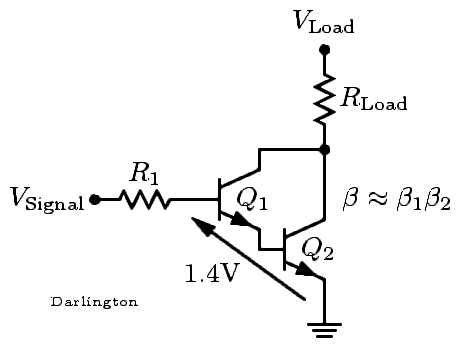Do you know about the junction forward voltage or V
be (This is called bias voltage as well). The junction forward voltage is the voltage applied to the emitter-base junction of a BJT in order to make the base conduct a specified current. For silicon transistors (most common) this is 0.71 V. Have a look at
http://en.wikipedia.org/wiki/Transistor ... r_material for other types.
The technique you wanted to use here is called Darlington pair (or just Darlington). A Darlington consists of two transistors. One is a smaller signal transistor and the other is a larger power transistor. The current gain is approximately the product of both transistors' forward current gains. One point to note is that as first transistor's emitter is connected to the base of the second one, the bias voltage required is Vbe1 + Vbe2. If both transistors are silicon type, this will be around 1.4 V (0.7 x 2).
In your circuit, the second transistors base stays at 0 V. So that is not even biased, how you can expect your circuit to work? I don't think this transistor combination has worked for you on a PIC 12F as you said. It is simply impossible.
It is important to learn some basic theory in electronics. That'll be very useful when you are doing some serious work.
Darlington comes as a single transistor (2 transistors in one) or set of Darlington pairs in a single IC called Darlington array. In the topic
What are the transistors that can handle high currents, I have mentioned some part numbers of Darlington pairs. If you buy a single ULN2003A IC, you'll be able to drive 7 outputs. Each output is a Darlington pair which can handle up to 500mA which is enough for your application.
If you need to make a Darlington pair yourself, here is the circuit diagram.

- Darlington.png (4.22 KiB) Viewed 16619 times
R
Load needs to be replaced with your LED set.
It will be easy for you if you try the Darlington transistor TIP120 (2 transistors packed in to one plastic module) or since you have many outputs ULN2003A which has 7 Darlington outputs. See the topic
What are the transistors that can handle high currents for information.










